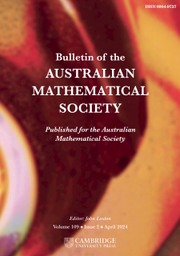No CrossRef data available.
Article contents
EVERY ARITHMETIC PROGRESSION CONTAINS INFINITELY MANY b-NIVEN NUMBERS
Published online by Cambridge University Press: 31 July 2023
Abstract
For an integer  $b\geq 2$, a positive integer is called a b-Niven number if it is a multiple of the sum of the digits in its base-b representation. In this article, we show that every arithmetic progression contains infinitely many b-Niven numbers.
$b\geq 2$, a positive integer is called a b-Niven number if it is a multiple of the sum of the digits in its base-b representation. In this article, we show that every arithmetic progression contains infinitely many b-Niven numbers.
Keywords
MSC classification
Secondary:
11B25: Arithmetic progressions
Information
- Type
- Research Article
- Information
- Copyright
- © The Author(s), 2023. Published by Cambridge University Press on behalf of Australian Mathematical Publishing Association Inc.
References
Cooper, C. and Kennedy, R. E., ‘On consecutive Niven numbers’, Fibonacci Quart. 31 (1993), 146–151.CrossRefGoogle Scholar
De Koninck, J.-M., Doyon, N. and Kátai, I., ‘On the counting function for the Niven numbers’, Acta Arith. 106 (2003), 265–275.CrossRefGoogle Scholar
De Koninck, J.-M., Doyon, N. and Kátai, I., ‘Counting the number of twin Niven numbers’, Ramanujan J. 17 (2008), 89–105.CrossRefGoogle Scholar
Grundman, H., ‘Sequences of consecutive
 $n$
-Niven numbers’, Fibonacci Quart. 32 (1994), 174–175.CrossRefGoogle Scholar
$n$
-Niven numbers’, Fibonacci Quart. 32 (1994), 174–175.CrossRefGoogle Scholar
Grundman, H., Harrington, J. and Wong, T. W. H., ‘Arithmetic progressions of
 $b$
-Niven numbers’, Rocky Mountain J. Math., to appear.Google Scholar
$b$
-Niven numbers’, Rocky Mountain J. Math., to appear.Google Scholar
Wilson, B., ‘Construction of
 $2\ast n$
consecutive
$2\ast n$
consecutive
 $n$
-Niven numbers’, Fibonacci Quart. 35 (1997), 122–128.Google Scholar
$n$
-Niven numbers’, Fibonacci Quart. 35 (1997), 122–128.Google Scholar


